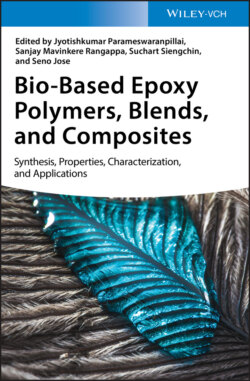Читать книгу Bio-Based Epoxy Polymers, Blends, and Composites - Группа авторов - Страница 18
1.3.4 Isosorbide
ОглавлениеIsosorbide (1,4:3,6‐dianhydro‐D‐glucitol) is an organic oxygen‐containing heterocyclic compound composed of two fused furan rings (Figure 1.40).
Isosorbide does not occur naturally. It can be obtained from various raw materials by organic synthesis through different reaction pathways. However, nowadays, isosorbide is produced from diverse polysaccharides through the multistep process that includes several intermediates [120] (Figure 1.41).
The synthesis of isosorbide can start from polysaccharides (mainly starch or cellulose biomass) or directly from all of the intermediate compounds because they are currently commercially available on a large scale. Lignocellulosic biomass is considered as one of the best resource due to its abundancy, versatility, and price [121]. The synthetic process of isosorbide production from polysaccharides consists of the following stages: acid‐catalyzed hydrolysis of the glycosidic bonds in the polymeric carbohydrates, hydrogenation of obtained glucose to sorbitol and further dehydration to sorbitan, and finally dehydration of sorbitan to isosorbide. Moreover, the different side reactions (such as degradation or polymerization) can occur in this complex process. Therefore, different new synthesis strategies (including the one‐step synthesis from glucose and cellulose) and catalysts are still elaborated and proposed [122].
Isosorbide can be derivatized by functionalization or substitution of the two secondary hydroxyl groups present in its molecule. A certain difficulty is the different reactivity and steric hindrance of the hydroxyl groups (against, due to these, a selective monoderivatization is also possible). Nevertheless, isosorbide is currently converted to valuable derivatives for use as pharmaceuticals, detergents, emulsifiers for cosmetics, surfactants, stabilizers, or plasticizers. In addition to the above‐mentioned applications, for a long time, isosorbide is considered and intensively studied as a potential monomer building block for the biopolymeric materials (e.g. polycarbonates, polyurethanes, or polyesters). As the bio‐based diol with bicyclic rigid structure isosorbide can also be applied as a substitute for bisphenol A replacement, there are generally two ways for introducing an epoxy functionality into the isosorbide molecule (Figure 1.42): conversion to the diallylic derivative, followed by oxidation to oxirane rings (the first pathway) and reaction with epichlorohydrin (the second and third pathways).
Figure 1.42 Possible reaction pathways for the synthesis of the diepoxide derivative of isosorbide.
Figure 1.43 Structure of isosorbide‐based epoxy resins.
Figure 1.44 Synthetic route of diallyl isosorbide and isosorbide diglycidyl ether.
In fact, the chemical structure of the diglycidyl isosorbide derivative shown in Figure 1.42 is valid only for the first reaction pathway. Only by the reaction with allyl bromide, followed by oxidation of the terminal unsaturated bonds, it is possible to obtain the product containing only one isosorbide molecule (the monomer). For the remaining reaction pathways, even the use of a large excess of epichlorohydrin leads to the formation of the products with an oligomer structure (Figure 1.43).
According to the first reaction pathway, the diallyl ether can be prepared by heating the isosorbide with allyl bromide in sodium hydroxide solution (Figure 1.44) [123].
Oxidation of diallyl isosorbide ether to isosorbide diglycidyl ether is carried out in the reaction with meta‐chloroperbenzoic acid as an oxygen carrier. It is also possible to use 4‐allyoxybenzoly chloride to introduce the diallyl functionality (Figure 1.45) [124].
The next stage of the reaction is carried out using the meta‐chloroperbenzoic acid, as described above.
The synthesis of isosorbide‐based epoxy resins using epichlorohydrin (Figure 1.43) can be accomplished in a different manner. Isosorbide can be reacted with a large excess (even a 10‐fold) of epichlorohydrin in the presence of strong alkali–sodium hydroxide (40% aq. solution) in a single‐stage reactor with continuous removal of water [125]. The reaction is carried out at a temperature of 109–115 °C for eight hours and the product with an epoxy value of 0.451–0.467 mol/100 g is obtained. In another method, sodium hydride as a base in diglyme is used to prepare the disodium salt of isosorbide (reaction time about six hours at a temperature of 43–48 °C and then one hour at a temperature of 85 °C) [126], which is then reacted with nearly 20‐fold excess of epichlorohydrin (six hours of dropwise addition, leaving overnight at room temperature, and heating for 2.5 hours at a temperature of 55 °C). The resulted product is obtained with an epoxy value of 0.359 mol/100 g. Sodium hydroxide (50% aq. solution) can be used instead of sodium hydride [127], also in the two‐step method. The disodium salt of isosorbide synthesis is catalyzed by trimethylcetylammonium bromide. In the second step, the disodium salt is reacted with the 10‐fold excess of epichlorohydrin in the presence of another phase transfer catalyst – tetrabutylammonium bromide (heating at a temperature of 115 °C for about three hours is carried out). The obtained isosorbide‐based epoxy resin has an epoxy value of 0.518 mol/100 g.
It is also possible to react isosorbide with epichlorohydrin in a two‐stage process under different conditions [128]: using an aqueous alkali (mostly sodium/potassium hydroxide) and an organic solvent (toluene and dimethyl acetamide) or the first stage is carried out in the presence of the Lewis acid catalyst (stannous fluoride).
The cross‐linked bio‐based epoxy resin (an epoxy value of 0.440 mol/100 g), synthesized in the one‐step reaction from isosorbide and epichlorohydrin [129] in the presence of 50% aqueous NaOH, exhibits properties comparable to those of the commercial bisphenol A‐based resin Epidian 5 (an epoxy value of 0.510 mol/100 g). Depending on the cross‐linking agent used (triethylenetetramine, isophoronediamine, tetrahydrophthalic, and phthalic anhydrides), the selected mechanical properties of the isosorbide‐based resin are in some cases even better (the flexural and compression strengths and the Brinell hardness). Also, the Izod impact strength of this resin is usually better than that of the cross‐linked resin Epidian 5 (even more than four times). Water sorption of the isosorbide‐based resin is much higher than that of the bisphenol‐A‐based resin (for the sample cross‐linked with triethylenetetramine, even their disintegration is observed), and as a result, the chemical resistance is less than that for the resin Epidian 5.
Figure 1.45 Synthesis of isosorbide diglycidyl ether using 4‐allyoxybenzoly chloride.
Figure 1.46 Formation of plant terpenes.
